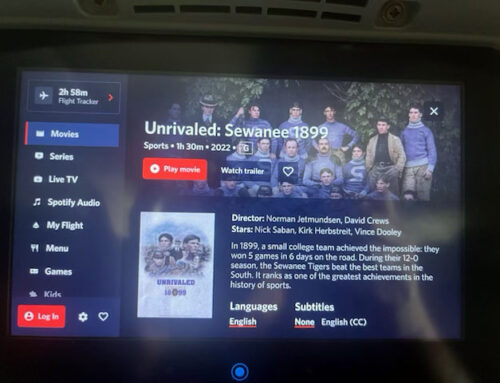Principles, money and pride: Why Sewanee and Georgia Tech left the SEC before it took off

August 24, 2023 NOTE: This is part of a weeklong series on the future of the Southeastern Conference.
One warm October afternoon 124 years ago, a 13-man college football team visited Atlanta and blitzed Georgia Tech off its home field. The Techs, as folks referred to them back in 1899, lost 32-0.
But two writers at the Atlanta Constitution newspaper awarded them a moral victory. One scribe was impressed that Georgia Tech kept the score close in the first half. And the other noted that it had lost by “only” 32 points.
The team on the other side was simply too fast, too strong and too dominant. But it wasn’t one of the traditional football powers — not Georgia, Clemson, Alabama or Auburn. Not even Tennessee, Ole Miss or LSU.

The stained-glass window in the All Saints Chapel at the University of the South (aka Sewanee) is a reminder of how important football and the legacy of the 1899 team remains at the school, as seen in Unrivaled: Sewanee 1899.
It was Sewanee, now a small Division III private liberal arts university that sits 2,000 feet above sea level in Tennessee, nestled among the mountains atop Appalachia’s Cumberland Plateau.
In 1899, Sewanee fielded one of the best teams in college football history. It finished the season 12-0 and famously won five road games in six days — in an era before players wore helmets, threw forward passes or even made substitutions.
The combined score of those five games: 91-0.
Sewanee and Georgia Tech shared a field that day in the first week of the 1899 season. Today, the two schools have very little in common. One is on a mountain in a small town. The other resides in a bustling major city. What they do share is a largely forgotten history as charter members of the original Southeastern Conference — and a fateful decision to leave the league before it rocketed to the top of the college sports world.
Sewanee never looked back, but Georgia Tech tried to rejoin the SEC just nine years later.
It’s a regret that still lingers around Georgia Tech today, given the SEC’s new television deal with ESPN and ABC. The 10-year, $3 billion deal — which kicks in before the 2024 football season — dramatically will increase the conference’s annual revenue and the amount it distributes to each of its member schools, which will number 16 when Texas and Oklahoma come aboard.
But Sewanee is content with its decision to leave the conference, athletic director John Shackelford said.
“It’s just a choice that was made back then,” he said, “and I would say we’re happy with our choice. We love the education that we’re able to provide for our students.”
‘An intentional decision to stay small’
When Shackelford brings visitors through Sewanee’s basketball gym, he tells them that the school used to host SEC games there.
“They can’t fathom that,” Shackelford said. “You know, those are the interesting facts, but I don’t know that it’s a well-known fact anymore that we were a founding member of the SEC.”
Today, Sewanee competes at the Division III level in the Southern Athletic Association. Its athletic department fields 24 teams, and more than 30% of its students are varsity athletes. The school honors the 1899 football team with a plaque on a flagpole at its football field and a stained-glass window in the on-campus chapel.
“Our roads diverged back in 1930,” Shackelford said. “We’re different, and we’re proud of what we are. More and more kids are attracted to the culture we have to offer.”
On Saturday, Louisiana PBS will re-air an Emmy-nominated documentary on the 1899 team titled “Unrivaled: Sewanee 1899” by filmmaker Norman Jetmundsen, a Sewanee alumnus who spent five years researching and producing the film.
In his research, Jetmundsen found that Sewanee athletics were facing financial problems around the time they left the SEC in 1940. They fought similar battles even at the turn of the 20th century. In 1898, the football team played just four games.
That severely limited travel funds for the following season. So team manager Luke Lea crafted a creative solution: He scheduled four games for the Tigers on their way back home from their game against Texas in Austin. Those next four games were against Texas A&M, Tulane, LSU and Ole Miss. Sewanee breezed through all five games in one week, solidifying its place in history.
But as the South’s public schools grew in the decades to come, Sewanee stayed small.
In the six years between the start of the SEC in 1933 and Sewanee’s decision to leave, the Tigers lost all 37 games they played against conference opponents. By the time they left, the only SEC opponent they played annually was Vanderbilt.
At the time, then-vice chancellor Alexander Guerry said that a small liberal arts college such as Sewanee simply could no longer compete with large universities in football without sacrificing its founding principles.
So he pulled the school out of the SEC.
“I think that originally, finances dictated that they stay small,” Jetmundsen said. “And as the other schools continued to get bigger and bigger, Sewanee made the conscious decision that they really wanted to stay small. They didn’t want to become a large university. They wanted to focus on student-faculty relationships, liberal arts, Division III sports.”
“And so, what started out, I think, as a financial decision became an intentional decision to stay small.”
‘It kind of backfired’
The Jan. 23, 1964, issue of The Atlanta Journal quotes Bobby Dodd saying he never gave the SEC an ultimatum. But the words and actions of the former Georgia Tech athletic director and head football coach indicate otherwise.
Georgia Tech left the SEC because the conference wouldn’t modify the so-called “140 rule,” which permitted schools to give a maximum of 45 football and basketball scholarships per year, but only 140 total. The problem: If a school put 45 new students on athletic scholarships annually, they’d quickly exceed the maximum total allowed.
Unless, of course, they stripped scholarships from underperforming players. To Dodd, that was a bridge too far.
So instead, Georgia Tech signed just 35 scholarship athletes per year, putting it at a competitive disadvantage to the schools that were willing to give out 45. When the rest of the conference leaders voted in 1964 to keep the 140 rule in place, Georgia Tech withdrew from the SEC and went independent.
For an article he penned in the 2011 issue of the Georgia Tech alumni magazine, an Atlanta residential designer named Mitchell Ginn researched the topic, imagining an alternative reality in which his alma mater never left the SEC.
“It kind of backfired on (Dodd),” Ginn said. “I think he meant well. It was a good battle to fight. But he shouldn’t have had the ultimatum of, ‘If the SEC doesn’t change the rule, we’re gonna pull out.’ Of course, hindsight’s 20/20.”
Over the 30 years it played in the SEC, Georgia Tech football posted a .646 winning percentage. That number fell to .509 for its 18 years as an independent.
In the decades following Dodd’s decision, the university’s enrollment more than tripled, its alumni base more than doubled in size, and the Atlanta metropolitan area population grew threefold, leading Ginn to make a “startling” comparison.
By 2010, he wrote, Georgia Tech’s average attendance at football games was lower than it was in 1963.
“So, there’s a lot of things that happened that created just a terrible situation for them,” Ginn said, “and they had to work their way out of it. They’re still fighting against some of those missteps today.”
Email Reed Darcey at Reed.Darcey@theadvocate.com.




